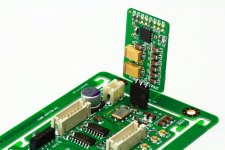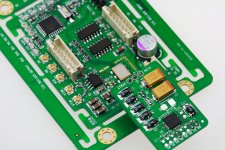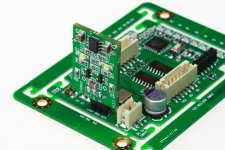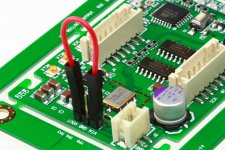While waiting for the Si570 Clock-Board...
...here is what I believe I am hearing after one week of operation (not sure if burn-in is yet complete):
(Setup: Alix-A1 with MPDPUP+SoTM-Usb-Card-->WavioIO-->Fifo--> Dual Mono BIII-->Broskie-Unbalancer; Wavio to FIFO through the card's isolator; Wave-IO power by LT1085 while FiFO powered by Placid-HD-Shunt-PSU. Normal Cables (not U.-FL) provided with the FIFO-Kit used to connect WaveIO with FifO and with Buffalo-Boards. Dul-XO-Board with two Crystek 957 @22.x and 24.x)
....what I hear:
A much more analog sound. The tonality is warmer, richer, less technical. The positioning right and left is much better, but maybe a little flatter, not so deep space. Flow of music is more "natural" and liquid. Clearly it goes in the right direction.
What I currently feel on the other handside is: A very small loss of dynamics and attack. A little bit of "air" and space seems to be gone. Somehow it reminds me of some compression-effects I had when using power-line-filters compared to no filters. It plays now like a very controlled, civilized musician vs Joe Coecker before (a little rough and wrong before, but really dynamic). Strange.
So, obviously I want to get the handbrake out of the way...any thoughts on this or similar experiences ?
What I could imagine to try out:
- Improve the cables between WaveIO and FiFO and BIII: Get rid of the normal Kit-Cables and use either pure silver-gold-cables from Mundorf (which I used before to connect WaveIO with BIII) or try U.FL instead
- Battery-Supply instead of the Placid-HD shunt-supply
Any opinions / hints ? Similar experiences ?
Best Regards
...here is what I believe I am hearing after one week of operation (not sure if burn-in is yet complete):
(Setup: Alix-A1 with MPDPUP+SoTM-Usb-Card-->WavioIO-->Fifo--> Dual Mono BIII-->Broskie-Unbalancer; Wavio to FIFO through the card's isolator; Wave-IO power by LT1085 while FiFO powered by Placid-HD-Shunt-PSU. Normal Cables (not U.-FL) provided with the FIFO-Kit used to connect WaveIO with FifO and with Buffalo-Boards. Dul-XO-Board with two Crystek 957 @22.x and 24.x)
....what I hear:
A much more analog sound. The tonality is warmer, richer, less technical. The positioning right and left is much better, but maybe a little flatter, not so deep space. Flow of music is more "natural" and liquid. Clearly it goes in the right direction.
What I currently feel on the other handside is: A very small loss of dynamics and attack. A little bit of "air" and space seems to be gone. Somehow it reminds me of some compression-effects I had when using power-line-filters compared to no filters. It plays now like a very controlled, civilized musician vs Joe Coecker before (a little rough and wrong before, but really dynamic). Strange.
So, obviously I want to get the handbrake out of the way...any thoughts on this or similar experiences ?
What I could imagine to try out:
- Improve the cables between WaveIO and FiFO and BIII: Get rid of the normal Kit-Cables and use either pure silver-gold-cables from Mundorf (which I used before to connect WaveIO with BIII) or try U.FL instead
- Battery-Supply instead of the Placid-HD shunt-supply
Any opinions / hints ? Similar experiences ?
Best Regards
Last edited:
Your cable idees are not anchored in reality - look elsewhere.
I will as well. Nevertheless the sound of digital cables is as much different as analog ones.
Nevertheless the sound of digital cables is as much different as analog ones.
If it makes you happy...
What I currently feel on the other handside is: A very small loss of dynamics and attack. A little bit of "air" and space seems to be gone. Somehow it reminds me of some compression-effects I had when using power-line-filters compared to no filters. It plays now like a very controlled, civilized musician vs Joe Cocker before (a little rough and wrong before, but really dynamic). Strange.
These are the typical reactions I hear when extraneous RF junk and powerline noise is removed. Putting the noise back usually makes users happy if they want the "dynamics" but it leaves a big question about the accuracy of the system. I would suggest listening to well recorded cymbal crashes for the separation of the transients and the tail to get a clear idea of which is more accurate. Paul Stubblebine of the Tape Project and a very good mastering engineer, showed me this trick. One common pitfall is to "tune/balance" a system, lowering the highs, to compensate for the extra HF grunge. Removing grunge usually requires a complete reevaluation of everything.
These are the typical reactions I hear when extraneous RF junk and powerline noise is removed. Putting the noise back usually makes users happy if they....
Hear, hear....
While waiting for the Si570 Clock-Board...
...here is what I believe I am hearing after one week of operation (not sure if burn-in is yet complete):
(Setup: Alix-A1 with MPDPUP+SoTM-Usb-Card-->WavioIO-->Fifo--> Dual Mono BIII-->Broskie-Unbalancer; Wavio to FIFO through the card's isolator; Wave-IO power by LT1085 while FiFO powered by Placid-HD-Shunt-PSU. Normal Cables (not U.-FL) provided with the FIFO-Kit used to connect WaveIO with FifO and with Buffalo-Boards. Dul-XO-Board with two Crystek 957 @22.x and 24.x)
I bolded your answer
So, obviously I want to get the handbrake out of the way...any thoughts on this or similar experiences ?
What I could imagine to try out:
- Improve the cables between WaveIO and FiFO and BIII: Get rid of the normal Kit-Cables and use either pure silver-gold-cables from Mundorf (which I used before to connect WaveIO with BIII) or try U.FL instead
- Battery-Supply instead of the Placid-HD shunt-supply
Any opinions / hints ? Similar experiences ?
Best Regards
Faster clocks first. Battery power supplies later.
There was this post not long ago in the FIFO GB thread that might help you try faster CCHD957 clocks
Hi,
I ordered wrongly the Crystek clocks: HCMOS 45.xx/49.xx Is anybody interested or willing to swap for two Crystek HCMOS 22.xx/24.xx ?
Please P.M.,
Ed
Faster clocks first. Battery power supplies later.
That is a very good hint...I have somewhere the faster versions of the tentclocks...the 957 was not in stock at Mouser right now, but is on backorder...I am not using the Buffalo III currently in sync-mode, but still with their own clocks...but you made the experience with the faster clocks ?
BTW: I did check the manuals V1 and V2 of the dual-clocks, but to be honest I did not saw a real difference in terms of setup for the faster clocks...maybe I missed something ? Simply plug the 22/24 and play the 44/49 ?
Best Regards
Ian:
How does the Si570 compare to dual XO-board with 90.x/98.x M XO when playing hi-res material (>24/192)? The dual XO would theoretically be better then - but is it audible?
Also, will there ever be a FIFO that would work with 2048*fs?
Hi RollE2K,
Dual XO Clock board does not support 90.xxx and 98.xxx so far. So it would be unfair comparing it with Si570 running at that frequency.
A couple of month ago, I listen to Si570 and dual xo 45/49 almost half and half. But now, after Si570 V3.0 starts running, I never get back to dual xo. But it might be just my personal preference.
Ian
While waiting for the Si570 Clock-Board...
...here is what I believe I am hearing after one week of operation (not sure if burn-in is yet complete):
(Setup: Alix-A1 with MPDPUP+SoTM-Usb-Card-->WavioIO-->Fifo--> Dual Mono BIII-->Broskie-Unbalancer; Wavio to FIFO through the card's isolator; Wave-IO power by LT1085 while FiFO powered by Placid-HD-Shunt-PSU. Normal Cables (not U.-FL) provided with the FIFO-Kit used to connect WaveIO with FifO and with Buffalo-Boards. Dul-XO-Board with two Crystek 957 @22.x and 24.x)
....what I hear:
A much more analog sound. The tonality is warmer, richer, less technical. The positioning right and left is much better, but maybe a little flatter, not so deep space. Flow of music is more "natural" and liquid. Clearly it goes in the right direction.
What I currently feel on the other handside is: A very small loss of dynamics and attack. A little bit of "air" and space seems to be gone. Somehow it reminds me of some compression-effects I had when using power-line-filters compared to no filters. It plays now like a very controlled, civilized musician vs Joe Coecker before (a little rough and wrong before, but really dynamic). Strange.
So, obviously I want to get the handbrake out of the way...any thoughts on this or similar experiences ?
What I could imagine to try out:
- Improve the cables between WaveIO and FiFO and BIII: Get rid of the normal Kit-Cables and use either pure silver-gold-cables from Mundorf (which I used before to connect WaveIO with BIII) or try U.FL instead
- Battery-Supply instead of the Placid-HD shunt-supply
Any opinions / hints ? Similar experiences ?
Best Regards
Blitz,
In your case, I would suggest:
1, Try 45.xxx/49.xxx XOs. CCHD957 might be one of the best;
2, Better power supply of battery power
Good luck to your project,
Ian
Si570 Clock Board V3.0(3) – How to power it
There are two ways powering the Si570 clock board: Power from FIFO by 10P FFC/FPC cable via J7, or power from external power supply via DC input J2. Either of them will be suitable for different situation:
1, Connecting the Si570 clock board directly to FIFO board
In this case, Si570 clock board is powered automatically by the 10P FFC/FPC cable from FIFO. You have to leave the DC input connector J2 unconnected all the time; otherwise two DC powers will be short together, except you remove L10 on the Si570 clock board, which is not recommended.
2, Connecting the Si570 clock board with isolator board first, then FIFO board
This the best way running the clock board to ensure lowest EMI noise by cutting the ground loop. In this case, you have to power the Si570 clock board from external power supply by DC input J2. Very well filtered and regulated DC power supply is required. However battery based power solutions are always being recommended to achieve super low noise performance without paying too much.
3, Running Si570 clock board as a stand along audio clock generator without connecting to a FIFO
In this case, you have to power the Si570 clock board from external power supply by DC input J2.
Ian
There are two ways powering the Si570 clock board: Power from FIFO by 10P FFC/FPC cable via J7, or power from external power supply via DC input J2. Either of them will be suitable for different situation:
1, Connecting the Si570 clock board directly to FIFO board
In this case, Si570 clock board is powered automatically by the 10P FFC/FPC cable from FIFO. You have to leave the DC input connector J2 unconnected all the time; otherwise two DC powers will be short together, except you remove L10 on the Si570 clock board, which is not recommended.
2, Connecting the Si570 clock board with isolator board first, then FIFO board
This the best way running the clock board to ensure lowest EMI noise by cutting the ground loop. In this case, you have to power the Si570 clock board from external power supply by DC input J2. Very well filtered and regulated DC power supply is required. However battery based power solutions are always being recommended to achieve super low noise performance without paying too much.
3, Running Si570 clock board as a stand along audio clock generator without connecting to a FIFO
In this case, you have to power the Si570 clock board from external power supply by DC input J2.
Ian
Si570 Clock Board V3.0(5) – External regulator solutions
Since on board LDO is removed, 3.3V regulator is now open to the external power supply solution from 3P SIP connector TP3,TP4,TP5. Where TP5=VIN;TP4=GND;TP3=VOUT; quite standard pin out. High quality low noise external power supply could be integrated with this clock board to boost the Si570 performance. Different power solutions can be experienced and selected according to personal preference.
Some of the possible power solutions are:
1, TPS7A4700 low noise LDO board
This reg board is confirmed to be one of the best LDO boards so far to power the clock board. You can connected to it by plugging into the 3P SIP socket, but it would be better to be soldered directly to the pins once you decided to stick with it. TPS7A4700 reg board could be placed both in vertical and in horizontal position to the clock board.
2, Third party 3PIN reg boards
We will have many choices such as TP 3.3V Trident and etc. But have to make sure the output current is enough to power Si570 clock board which is rated at 150mA.
3, Shunt regulators
Any 3.3V Shunt regulator can work for the Si570 clock board. But the high frequency performance has to be confirmed suitable powering oscillators.
4, Direct 3.4V LiFePO4 battery cell
To achieve this configuration, we have to
(1), Running Si570 clock board with an isolator board or in stand along mode
(2), Short VIN and VOUT pins by a jumper
(3), Connect to a 3.4V LiFePO4 battery cell or battery management board from DC input connector J2.
If running with an isolator board, half of the isolator board will be powered by the same 3.4V battery automatically from 10P FFC/FPC cable. Usually we don’t need remove or bypass the LDO on isolator board because most of LDOs is tested still be capable enough to power the half isolator with 3.4V input (the output will be a bit lower than 3.3V).
5, Standard TO220-3 3.3V 3 terminal regular IC
We can find tons of those LDOs, such as 78M33, for testing is OK. But not recommended for real operating because of the noise performance.
Please note, a good linear regulator for an audio amplifier may no longer be good for an oscillator. To power a XO, we need a regulator not only has perfect low noise performance but also can keep that good performance for high frequency RF/VCO applications.
Ian
Since on board LDO is removed, 3.3V regulator is now open to the external power supply solution from 3P SIP connector TP3,TP4,TP5. Where TP5=VIN;TP4=GND;TP3=VOUT; quite standard pin out. High quality low noise external power supply could be integrated with this clock board to boost the Si570 performance. Different power solutions can be experienced and selected according to personal preference.
Some of the possible power solutions are:
1, TPS7A4700 low noise LDO board
This reg board is confirmed to be one of the best LDO boards so far to power the clock board. You can connected to it by plugging into the 3P SIP socket, but it would be better to be soldered directly to the pins once you decided to stick with it. TPS7A4700 reg board could be placed both in vertical and in horizontal position to the clock board.
2, Third party 3PIN reg boards
We will have many choices such as TP 3.3V Trident and etc. But have to make sure the output current is enough to power Si570 clock board which is rated at 150mA.
3, Shunt regulators
Any 3.3V Shunt regulator can work for the Si570 clock board. But the high frequency performance has to be confirmed suitable powering oscillators.
4, Direct 3.4V LiFePO4 battery cell
To achieve this configuration, we have to
(1), Running Si570 clock board with an isolator board or in stand along mode
(2), Short VIN and VOUT pins by a jumper
(3), Connect to a 3.4V LiFePO4 battery cell or battery management board from DC input connector J2.
If running with an isolator board, half of the isolator board will be powered by the same 3.4V battery automatically from 10P FFC/FPC cable. Usually we don’t need remove or bypass the LDO on isolator board because most of LDOs is tested still be capable enough to power the half isolator with 3.4V input (the output will be a bit lower than 3.3V).
5, Standard TO220-3 3.3V 3 terminal regular IC
We can find tons of those LDOs, such as 78M33, for testing is OK. But not recommended for real operating because of the noise performance.
Please note, a good linear regulator for an audio amplifier may no longer be good for an oscillator. To power a XO, we need a regulator not only has perfect low noise performance but also can keep that good performance for high frequency RF/VCO applications.
Ian
Attachments
Last edited:
First pic look like a big membrane microphone is attached to the clock board :-D
Was real environment playing loud music evaluated wrt. on board LDO vs. TPS7A4700 board. When I reason around this I come back to that an onboard LDO would probably in most cases in the real practical world, perform batter.
/
/
Was real environment playing loud music evaluated wrt. on board LDO vs. TPS7A4700 board. When I reason around this I come back to that an onboard LDO would probably in most cases in the real practical world, perform batter.
/
/
- Home
- Source & Line
- Digital Line Level
- Asynchronous I2S FIFO project, an ultimate weapon to fight the jitter




